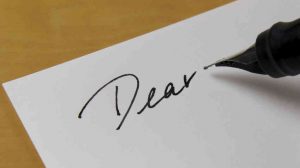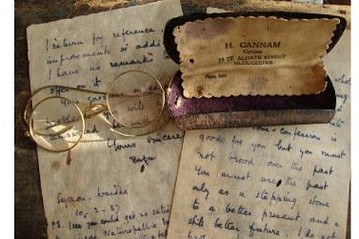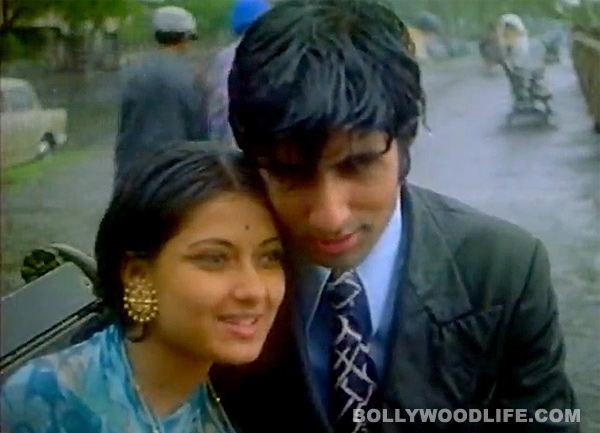Do you recall when the last time you wrote a hand-written letter? And whom did you write it to? What contents? My question might sound dramatic, but I feel the Letter writing is lost its ground to emails, and mobile messaging. We are connected to the world through Internet, face book, WhatsApp, Twitter and many more apps on our mobile phones. We text and email in acronyms, in short cuts to convey our feelings very shallowly. As a modern society we have found shortcuts for everything including our lexis.
How letter writing was important once upon a time
Letter writing was a basic element of everyday life for most people throughout the 19th Century and also few years of the 20th Century. The afternoons were speared for letter writing by women and older people in the households. Letter writing was the only way one could keep in touch with relatives and friends. During good and bad times people would wait eagerly to receive letters from their near and dear ones. During wars, floods, famines, people kept connected with their families by writing letters. It is indeed an art – I call it an art because it is submission of expression of human creative skill and imagination while writing. Letter writing started declining as early as the middle of the 20th Century. I guess it was because of introduction of good quality in telephone service at cheaper rates. And, then came in the computer, which made us so lazy that we stopped writing and got hooked on to the computer keyboards. We started electronically typed correspondences.
only way one could keep in touch with relatives and friends. During good and bad times people would wait eagerly to receive letters from their near and dear ones. During wars, floods, famines, people kept connected with their families by writing letters. It is indeed an art – I call it an art because it is submission of expression of human creative skill and imagination while writing. Letter writing started declining as early as the middle of the 20th Century. I guess it was because of introduction of good quality in telephone service at cheaper rates. And, then came in the computer, which made us so lazy that we stopped writing and got hooked on to the computer keyboards. We started electronically typed correspondences.
How letter writing helps
 When we write with use of paper and pen that is when we hand write, we need to use our brains – we need to concentrate more because we write the script without aid of spell-check and grammar-check which is available on computer. We need to focus on every world that we write. It requires concentration, world power, syntax, and forming sentences from mind. It has a magic. Try it and see how refreshing you feel. We have lost the fine art of letter writing to the musty and stale electronic typing. I think since then we have also become a society of shallow and condensed minds. A handwritten letter shows all the emotion and personality of the person who writes it. Handwritten letters allow us to immerse in the drama of love, hatred, tragedy, anger and loneliness. Most important – they are tangible!!!
When we write with use of paper and pen that is when we hand write, we need to use our brains – we need to concentrate more because we write the script without aid of spell-check and grammar-check which is available on computer. We need to focus on every world that we write. It requires concentration, world power, syntax, and forming sentences from mind. It has a magic. Try it and see how refreshing you feel. We have lost the fine art of letter writing to the musty and stale electronic typing. I think since then we have also become a society of shallow and condensed minds. A handwritten letter shows all the emotion and personality of the person who writes it. Handwritten letters allow us to immerse in the drama of love, hatred, tragedy, anger and loneliness. Most important – they are tangible!!!
It is only because of some preserved letters in historical galleries, attics, closets, and basements throughout the world about millions of men and women who have fought wars, who have served nations as civil servants, freedom fighters, great doctors, lawyers, accountants, scientists and politicians – in short people who brought some kind of revolution, the world is exposed to truth. Many of these letters are extremely significant, offering eyewitness accounts of famous battles, historic events, or encounters between prominent people. These personal letters show us heartfelt expressions of affection, hatred, anguish or words of support and encouragement between some great people which today offer valuable insight into their personalities. They need to be preserved.
 Recently, some correspondence by Paul Cezanne, P.G. Wodehouse and Christopher Isherwood add nuance to their influential lives. Few unpublished letters of Isaac Newton have thrown light on his profound research on spectrum of colors. Some letters written by Jawaharlal Nehru, Gandhi and Sardar Patel throw light on their ideologies and the reality of how India’s political landscape was getting shaped up. During the Margret Thatcher years, the special relationship between Britain and America was elevated to heights which were never achieved before or since. She and US president Ronald Reagan came to power at a critical time in world history and united to bring an end to the Cold War and change the face of international politics. Few letters written by them reveal how they helped each other to suit strategies to shape their respective nations.
Recently, some correspondence by Paul Cezanne, P.G. Wodehouse and Christopher Isherwood add nuance to their influential lives. Few unpublished letters of Isaac Newton have thrown light on his profound research on spectrum of colors. Some letters written by Jawaharlal Nehru, Gandhi and Sardar Patel throw light on their ideologies and the reality of how India’s political landscape was getting shaped up. During the Margret Thatcher years, the special relationship between Britain and America was elevated to heights which were never achieved before or since. She and US president Ronald Reagan came to power at a critical time in world history and united to bring an end to the Cold War and change the face of international politics. Few letters written by them reveal how they helped each other to suit strategies to shape their respective nations.
Did you know about first-hand account of the moments the Titanic sank written in a letter supposedly by a French maid
 It seems a tormenting first-hand account of the moments the Titanic sank in April 1912, has been uncovered in a letter supposedly from a French maid who survived the disaster. The hand-written in French is dated 8 August 1955. It was the woman’s maiden voyage. This French woman’s name was Rose Amelie Icard. It describes scenes of “horror” and “inspiring heroism” as passengers tried to escape the sinking vessel. The letter, written in blue ink, is addressed to a woman believed to be called Madame Austin, although the name is slightly unclear and no one of that name appears in the list of survivors.
It seems a tormenting first-hand account of the moments the Titanic sank in April 1912, has been uncovered in a letter supposedly from a French maid who survived the disaster. The hand-written in French is dated 8 August 1955. It was the woman’s maiden voyage. This French woman’s name was Rose Amelie Icard. It describes scenes of “horror” and “inspiring heroism” as passengers tried to escape the sinking vessel. The letter, written in blue ink, is addressed to a woman believed to be called Madame Austin, although the name is slightly unclear and no one of that name appears in the list of survivors.
Tragically, many of these correspondences are being thrown away, lost, or irreparably damaged. Saving these letters is not difficult, and it is an excellent way to learn about national heritage and history. Different letters need to be cared for in different ways. It’s an art of preserving letters with scientific support.
How receiving a letter is important?
 There is nothing better than receiving a letter written by some close one in which that someone has put a lot of work into with earnest expressions. Though languages keep changing from time to time, but the way we open and close letters has stayed very much the same. A simple welcome/salutation – such as ‘hello’, ‘hi’, ‘dear’, ‘dearest’ can lead to a million budding and potential associations. And, adieu, such as ‘from yours truly’, ‘yours lovingly’, ‘sincerely’, ‘affectionately’ ‘with best wishes’ and so on, can create magic between the reader and the sender. This is a humble appeal to one and all – let us cherish the art of letter writing. With paper and pens being so readily available to us, there’s no better time – the present, now, this moment to recreate the magic of writing letters. Let’s fall in love with the art of letter writing again.
There is nothing better than receiving a letter written by some close one in which that someone has put a lot of work into with earnest expressions. Though languages keep changing from time to time, but the way we open and close letters has stayed very much the same. A simple welcome/salutation – such as ‘hello’, ‘hi’, ‘dear’, ‘dearest’ can lead to a million budding and potential associations. And, adieu, such as ‘from yours truly’, ‘yours lovingly’, ‘sincerely’, ‘affectionately’ ‘with best wishes’ and so on, can create magic between the reader and the sender. This is a humble appeal to one and all – let us cherish the art of letter writing. With paper and pens being so readily available to us, there’s no better time – the present, now, this moment to recreate the magic of writing letters. Let’s fall in love with the art of letter writing again.













































